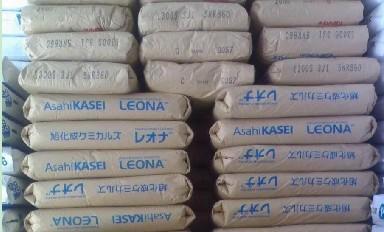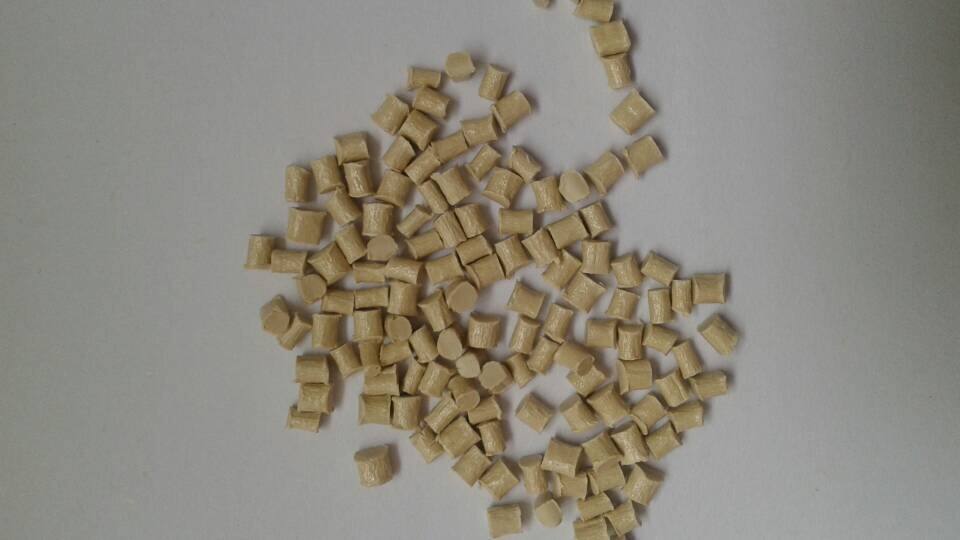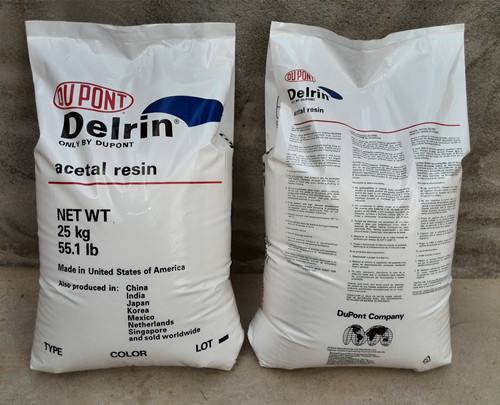POM 500T 美国杜邦
聚甲醛是一种没有侧链、高密度、高结晶性的线型聚合物,具有优异的综合性能。聚甲醛的拉伸强度可达70MPa,可在104℃下长期使用,脆化温度为-40℃,吸水性较小。但聚甲醛的热稳定性较差,耐候性较差,长期在大气中曝晒会老化。
聚甲醛的力学性能相当好,它具有较高的强度的弹性模量,摩擦系数小,耐磨性能好。聚甲醛还具有高度抗蠕变和应力松弛的能力。
聚甲醛尺寸稳定性好,吸水率很小,所以吸水率对其力学性能的影响可以不予考虑。聚甲醛有较好的介电性能,在很宽的频率和温度范围内,它的介电常数和介质损耗角正切值变化很小。
聚甲醛的耐热性较差,在成型温度下易降解放出皿醛,一般在造粒时加入稳定剂。若不受力,聚甲醛可在140℃下短期使用,其长期使用温度为85℃。
聚甲醛耐气候性较差,经大气老化后,一般性能均有所下降。但它的化学稳定性非常优越,特别是对有机溶剂,其尺寸变化和力学性能的降低都很少。但对强酸和强氧化剂如硝酸、硫酸等耐蚀性很差。
聚甲醛的拉伸强度达70MPa,吸水性小,尺寸稳定,有光泽,这些性能都比尼龙好,聚甲醛为高度结晶的树脂,在热塑性树脂中是最坚韧的。具抗热强度,弯曲强度,耐疲劳性强度均高,耐磨性和电性能优良。
POM具有很低的摩擦系数和很好的几何稳定性,特别适合于制作齿轮和轴承。由于它还具有耐高温特性,因此还用于管道器件(管道阀门、泵壳体),草坪设备等。
POM(聚甲醛树脂)定义:聚甲醛是一种没有侧链、高密度、高结晶性的线型聚合物。按其分子链中化学结构的不同,可分为均聚甲醛和共聚甲醛两种。两者的重要区别是:均聚甲醛密度、结晶度、熔点都高,但热稳定性差,加工温度范围窄(约10℃),对酸碱稳定性略低;而共聚甲醛密度、结晶度、熔点、强度都较低,但热稳定性好,不易分解,加工温度范围宽(约50℃),对酸碱稳定性较好。是具有优异的综合性能的工程塑料。有良好的物理、机械和化学性能,尤其是有优异的耐摩擦性能。俗称赛钢或夺钢,为第三大通用塑料。适于制作减磨耐磨零件,传动零件,以及化工,仪表等零件。一般性能
聚甲醛是一种表面光滑、有光泽的硬而致密的材料,淡黄或白色,薄壁部分呈半透明。燃烧特性为容易燃烧,离火后继续燃烧,火焰上端呈黄色,下端呈蓝色,发生熔融滴落,有强烈的刺激性甲醛味、鱼腥臭。聚甲醛为白色粉末,一般不透明,着色性好,比重1.41-1.43克/立方厘米,成型收缩率1.2-3.0%,成型温度170-200℃,干燥条件80-90℃2小时。POM的长期耐热性能不高,但短期可达到160℃,其中均聚POM短期耐热比共聚POM高10℃以上,但长期耐热共聚POM反而比均聚POM高10℃左右。可在-40℃~100℃温度范围内长期使用。POM极易分解,分解温度为280度,分解时有刺激性和腐蚀性气体发生。故模具钢材宜选用耐腐蚀性的材料制作。
力学性能
POM强度、刚度高,弹性好,减磨耐磨性好。其力学性能优异,比强度可达50.5MPa,比刚度可达2650MPa,与金属十分接近。POM的力学性能随温度变化小,共聚POM比均聚POM的变化稍大一点。POM的冲击强度较高,但常规冲击不及ABS和PC;POM对缺口敏感,有缺口可使冲击强度下降90%之多。POM的疲劳强度十分突出,10交变载荷作用后,疲劳强度可达35MPa,而PA和PC仅为28MPa。POM的蠕变性与PA相似,在20℃、21MPa、3000h时仅为2.3%,而且受温度的影响很小。POM的摩擦因数小,耐磨性好(POM>PA66>PA6>ABS>HPVC>PS>PC),极限PV值很大,自润滑性好。POM制品对磨时,高载荷作用时易产生类似尖叫的噪声。
电学性能
POM的电绝缘性较好,几乎不受温度和湿度的影响;介电常数和介电损耗在很宽的温度、湿度和频率范围内变化很小;耐电弧性极好,并可在高温下保持。POM的介电强度与厚度有关,厚度0.127mm时为82.7kV/mm,厚度为1.88mm时为23.6kV/mm。
环境性能
POM不耐强酸和氧化剂,对烯酸及弱酸有一定的稳定性。POM的耐溶剂性良好,可耐烃类、醇类、醛类、醚类、汽油、润滑油及弱碱等,并可在高温下保持相当的化学稳定性。吸水性小,尺寸稳定性好。
POM的耐候性不好,长期在紫外线作用下,力学性能下降,表面发生粉化和龟裂。
成形性
结晶料,熔融范围窄,熔融和凝固快,料温稍低于熔融温度即发生结晶。流动性中等。吸湿小,可不经干燥处理。
高粘度缩醛均聚物 POM美国杜邦 100P NC010霆尔塑化科技华南代理商”的详细描述:
DuPont™
Delrin
®
acetal resin
Delrin®
100P NC010
Identification
Resin Identification ISO 1043 POM
Part Marking Code ISO 11469 >POM<<br /> Mechanical
Yield Stress ISO 527 MPa (kpsi) 70 (10.2)
Yield Strain ISO 527 % 25
Strain at Break ISO 527 %
50mm/min 65
Nominal Strain at Break ISO 527 % 45
Tensile Modulus ISO 527 MPa (kpsi) 2900 (420)
Tensile Creep Modulus ISO 899 MPa (kpsi)
1h 2700 (392)
1000h 1500 (218)
Flexural Modulus ISO 178 MPa (kpsi) 2600 (377)
Flexural Stress ISO 178 MPa (kpsi)
@ 3.5% Strain 74 (10.7)
Notched Charpy Impact Strength ISO 179/1eA kJ/m
2
-30°C (-22°F) 11
23°C (73°F) 14
Unnotched Charpy Impact Strength ISO 179/1eU kJ/m
2
-30°C (-22°F) 350
23°C (73°F) N
Contact DuPont for Material Safety Data Sheet, general guides and/or additional information about ventilation, handling, purging, drying, etc
ISO Mechanical properties measured at 4.0mm, ISO Electrical properties measured at 2.0mm, and all ASTM properties measured at 3.2mm.
Test temperatures are 23°C unless otherwise stated.
The DuPont Oval Logo, DuPont™, The miracles of science™ and Delrin® are trademarks or registered trademarks of DuPont Company. Copyright© 2010
100216/100930
The information provided in this data sheet corresponds to our knowledge on the subject at the date of its publication. This information may be subject to revision as new
knowledge and experience becomes available. The data provided fall within the normal range of product properties and relate only to the specific material designated; these
data may not be valid for such material used in combination with any other materials, additives or pigments or in any process, unless expressly indicated otherwise
The data provided should not be used to establish specification limits or used alone as the basis of design; they are not intended to substitute for any testing you
may need to conduct to determine for yourself the suitability of a specific material for your particular purposes. Since DuPont cannot anticipate all variations
in actual end-use conditions DuPont makes no warranties and assumes no liability in connection with any use of this information. Nothing in this
publication is to be considered as a license to operate under or a recommendation to infringe any patent rights. DuPont advises you to seek independent
counsel for a freedom to practice opinion on the intended application or end-use of our products. CAUTION: Do not use DuPont materials in medical
application involving implantation in the human body or contact with internal body fluids or tissues unless the material has been provided from DuPont under
a written contract that is consistent with DuPont policy regarding medical applications and expressly acknowledges the contemplated use. For further information,
please contact your DuPont representative. You may also request a copy of DuPont POLICY Regarding Medical Applications H-50103-3 and
DuPont CAUTION Regarding Medical Applications … H-50102-3
plastics.
Delrin®
100P is a high viscosity acetal homopolymer for use in easy to fill molds. It has improved processing thermal
stability, good mechanical properties, toughness, and low volatile emissions.
Property Test Method Units Value
1 / 4Product Information
Delrin®
100P NC010
Thermal
Deflection Temperature ISO 75-1/-2 °C (°F)
0.45MPa 160 (320)
1.80MPa 93 (200)
Melting Temperature ISO 11357-1/-3 °C (°F)
10°C/min 178 (352)
CLTE, Parallel ISO 11359-1/-2 E-4/C (E-4/F)
-40 - 23°C (-40 - 73°F) 1.1 (0.61)
23 - 55°C (73 - 130°F) 1.1 (0.61)
55 - 100°C (130 - 212°F) 1.5 (0.84)
CLTE, Normal ISO 11359-1/-2 E-4/C (E-4/F)
-40 - 23°C (-40 - 73°F) 1.0 (0.56)
23 - 55°C (73 - 130°F) 1.1 (0.61)
55 - 100°C (130 - 212°F) 1.5 (0.82)
Specific Heat ISO 11357-4 J/kg K (Btu/lb F) 3000 (0.71)
Vicat Softening Temperature ISO 306 °C (°F)
50N 160 (320)
Rheological
Melt Mass-Flow Rate ISO 1133 g/10 min
190°C, 2.16kg 2.5
Melt Volume-Flow Rate ISO 1133 cm
3
/10 min (ml/10 min) 1.9
Electrical
Surface Resistivity IEC 60093 ohm >1E15
Volume Resistivity IEC 60093 ohm m 1E12
Relative Permittivity IEC 60250
1E2 Hz 3.8
1E6 Hz 3.7
Dissipation Factor IEC 60250 E-4
1E6 Hz 40
CTI IEC 60112 V 600
Contact DuPont for Material Safety Data Sheet, general guides and/or additional information about ventilation, handling, purging, drying, etc
ISO Mechanical properties measured at 4.0mm, ISO Electrical properties measured at 2.0mm, and all ASTM properties measured at 3.2mm.
Test temperatures are 23°C unless otherwise stated.
The DuPont Oval Logo, DuPont™, The miracles of science™ and Delrin® are trademarks or registered trademarks of DuPont Company. Copyright© 2010
100216/100930
The information provided in this data sheet corresponds to our knowledge on the subject at the date of its publication. This information may be subject to revision as new
knowledge and experience becomes available. The data provided fall within the normal range of product properties and relate only to the specific material designated; these
data may not be valid for such material used in combination with any other materials, additives or pigments or in any process, unless expressly indicated otherwise
The data provided should not be used to establish specification limits or used alone as the basis of design; they are not intended to substitute for any testing you
may need to conduct to determine for yourself the suitability of a specific material for your particular purposes. Since DuPont cannot anticipate all variations
in actual end-use conditions DuPont makes no warranties and assumes no liability in connection with any use of this information. Nothing in this
publication is to be considered as a license to operate under or a recommendation to infringe any patent rights. DuPont advises you to seek independent
counsel for a freedom to practice opinion on the intended application or end-use of our products. CAUTION: Do not use DuPont materials in medical
application involving implantation in the human body or contact with internal body fluids or tissues unless the material has been provided from DuPont under
a written contract that is consistent with DuPont policy regarding medical applications and expressly acknowledges the contemplated use. For further information,
please contact your DuPont representative. You may also request a copy of DuPont POLICY Regarding Medical Applications H-50103-3 and
DuPont CAUTION Regarding Medical Applications … H-50102-3
POM100
用途: 其它
特性备注:坚韧高粘性
重要参数: 熔体流动速率:2 g/10min 密度:1.37 g/cm3 吸水率:0.9 % 缺口冲击强度:2.5 拉伸强度:52 MPa 弯曲模量:1800 MPa 热变形温度:85 ℃
生产厂商:美国杜邦公司
POM100
用途: 其它
特性备注:特性:均聚甲醛,高粘度,具有最坚韧的硬度,优良的热稳定性。
重要参数: 吸水率:0.25 % 缺口冲击强度:123 硬度:120 热变形温度:136 ℃
生产厂商:美国杜邦公司
POM100
用途: 其它
特性备注:特性:具有优异的加工特性,在非改质材料中具有*高韧性。
重要参数: 密度:1.42 g/cm3 缺口冲击强度:137 拉伸强度:69 MPa 弯曲强度:98 MPa 弯曲模量:2840 MPa 硬度:120 热变形温度:136 ℃
生产厂商:美国杜邦公司
POM100
用途: 其它
特性备注:加工特性:高黏度树脂,适合较易充填之模具。表面经润滑。 产品特性:超强韧性聚甲醛树脂。
重要参数: 密度:1.34 g/cm3 拉伸强度:64 MPa 硬度:105 热变形温度:65 ℃
生产厂商:美国杜邦公司
POM
用途: 其它
特性备注:加工特性:一般表面润滑等级。 产品特性:韧性与DELRIN 100相近,低磨耗,但刚性与强硬度些微降低。
重要参数: 密度:1.39 g/cm3 成型收缩率:1.8 % 拉伸强度:58 MPa 弯曲强度:70 MPa 弯曲模量:2420 MPa 硬度:117 热变形温度:85 ℃
生产厂商:美国杜邦公司
POM100
用途: 其它
重要参数:
生产厂商:美国杜邦公司
POM100
特性包括:
- 阻燃/额定火焰
- 高分子量
- 高刚度
- 高强度
- 高粘度
| 总体 | ||||
|
材料状态
|
|
|||
|
资料 1
|
|
|||
|
UL 黄卡 2
|
||||
|
搜索 UL 黄卡
|
|
|||
|
供货地区
|
|
|||
|
性能特点
|
|
|||
|
用途
|
|
|||
|
RoHS 合规性
|
|
|||
|
外观
|
|
|||
|
形式
|
|
|||
|
加工方法
|
|
|||
|
部件标识代码 (ISO 11469)
|
|
|||
|
树脂ID (ISO 1043)
|
|
| 物理性能 |
额定值
|
单位制
|
测试方法
|
|
密度
|
1.42
|
g/cm³
|
ISO 1183 |
|
熔流率 (190°C/2.16 kg)
|
2.4
|
g/10 min
|
ISO 1133 |
|
溶化体积流率(MVR) (190°C/2.16 kg)
|
1.90
|
cm³/10min
|
ISO 1133 |
|
收缩率
|
ISO 294-4 | ||
|
横向流量 : 2.00 mm
|
2.0
|
%
|
|
|
流量 : 2.00 mm
|
1.8
|
%
|
|
|
吸水率 (23°C, 24 hr)
|
0.39
|
%
|
ISO 62 |
| 机械性能 |
额定值
|
单位制
|
测试方法
|
|
拉伸模量 (23°C)
|
3100
|
MPa
|
ISO 527-2 |
|
拉伸应力 (屈服, 23°C)
|
72.0
|
MPa
|
ISO 527-2 |
|
拉伸应变 (屈服, 23°C)
|
22
|
%
|
ISO 527-2 |
|
断张率 (23°C)
|
40
|
%
|
ISO 527-2 |
|
弯曲模量 (23°C)
|
2900
|
MPa
|
ISO 178 |
| 冲击性能 |
额定值
|
单位制
|
测试方法
|
|
简支梁缺口冲击强度
|
ISO 179/1eA | ||
|
-30°C
|
9.0
|
kJ/m²
|
|
|
23°C
|
12
|
kJ/m²
|
|
|
悬壁梁缺口冲击强度 (23°C)
|
10
|
kJ/m²
|
ISO 180/1A |
| 热性能 |
额定值
|
单位制
|
测试方法
|
|
热变形温度
|
|||
|
0.45 MPa, 未退火
|
165
|
°C
|
ISO 75-2/B |
|
1.8 MPa, 未退火
|
97.0
|
°C
|
ISO 75-2/A |
|
熔融温度 3
|
178
|
°C
|
ISO 11357-3 |
|
线形膨胀系数
|
ISO 11359-2 | ||
|
流动 : -40 到 23°C
|
0.00010
|
cm/cm/°C
|
|
|
流动 : 23 到 55°C
|
0.00011
|
cm/cm/°C
|
|
|
流动 : 55 到 100°C
|
0.00014
|
cm/cm/°C
|
|
|
横向 : -40 到 23°C
|
0.000090
|
cm/cm/°C
|
|
|
横向 : 23 到 55°C
|
0.00010
|
cm/cm/°C
|
|
|
横向 : 55 到 100°C
|
0.00015
|
cm/cm/°C
|
|
|
RTI Elec
|
UL 746 | ||
|
1.50 mm
|
50.0
|
°C
|
|
|
3.00 mm
|
50.0
|
°C
|
|
|
RTI Imp
|
UL 746 | ||
|
1.50 mm
|
50.0
|
°C
|
|
|
3.00 mm
|
50.0
|
°C
|
|
|
RTI Str
|
UL 746 | ||
|
1.50 mm
|
50.0
|
°C
|
|
|
3.00 mm
|
50.0
|
°C
|
| 电气性能 |
额定值
|
单位制
|
测试方法
|
|
耗散因数 (23°C, 1 MHz)
|
0.0060
|
|
IEC 60250 |
| 可燃性 |
额定值
|
单位制
|
测试方法
|
|
UL 阻燃等级
|
UL 94, IEC 60695-11-10, -20 | ||
|
1.50 mm
|
HB
|
|
|
|
3.00 mm
|
HB
|
|
| 注射 |
额定值
|
单位制
|
|
|
干燥温度
|
80.0
|
°C
|
|
|
干燥时间 - 热风干燥机
|
2.0 到 4.0
|
hr
|
|
|
建议的最大水分含量
|
< 0.20
|
%
|
|
|
加工(熔体)温度
|
210 到 220
|
°C
|
|
|
Melt Temperature, Optimum - Injection Molding
|
215
|
°C
|
|
|
模具温度
|
80.0 到 100
|
°C
|
|
|
Mold Temperature, Optimum - Injection Molding
|
90
|
°C
|
|
| 挤出 |
额定值
|
单位制
|
|
|
建议的最大水分含量
|
< 0.20
|
%
|
|
|
熔体温度
|
195 到 205
|
°C
|
|
|
Extrusion Melt Temperature, Optimum
|
200
|
°C
|




